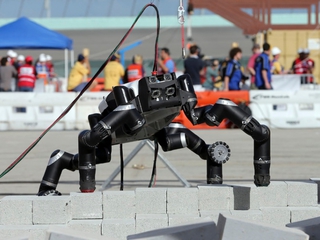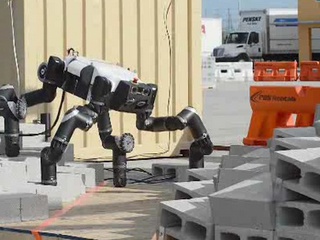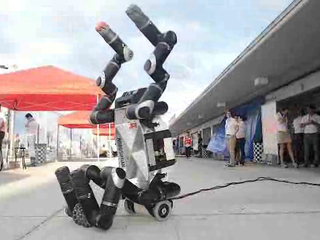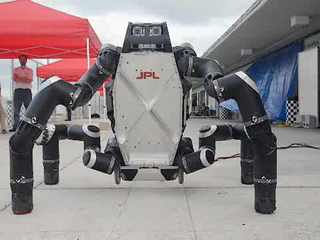RoboSimian
Robosimian is a four legged robot designed to look and act like a primate. It was created by robotics teams at NASA’s Jet Propulsion Lab. Robosimian highlights the need and the importance of designing the aesthetics, as well as function of future robots.
At NASA JPL, Dan Goods will work on pieces that go to art museums, like Hidden Light and Beneath the Surface, but he will equally collaborate with it’s research teams to help advance their outcomes. His work on RoboSimian, a robot to help in disaster scenarios, is a great example of this.
Robosimian is a four legged robot designed to look and act like a primate. It was created by robotics teams at NASA’s Jet Propulsion Lab and recently became a finalist in DARPA’s 2014 Robotics Challenge. Unlike many other robots that specialize in just one or two tasks, Robosimian can complete a wide array of tasks from opening doors, navigating complex terrain, clearing debris, to performing repair work. This required an impressive amount of engineering, but the team have also explored the ways in which robots can not only perform all of the needed tasks during an emergency situation but also fits in with the visual nomenclature of disaster response.
In the midst of a disaster, a robot could some day be the first thing encountered by an individual in this situation. This required them to think about its first impressions and how someone might perceive it during these stressful times. They wanted to develop ways to give it a friendlier feel. By using the reference of a panda bear they have looked to ‘soften up’ its appearance. In addition to its visual appearance, they have also considered the ways in which color is used to represent emergency responders, as well the aesthetics of the robot’s movement.
The robot still has to have certain capabilities, however, so there are some limitations on movement, aesthetics and form to allow for its needed functionality. Robosimian is intended to highlight a stepping-stone towards a possible future in automated disaster response.
Reaction and Response
People are interacting with robots more and more and over the next decade, these interactions are set to increase. The priority in these interactions is often the function and their execution of tasks, rather than the form. This is to be expected as most of the robots we see today are designed primarily by engineers and to meet particular capabilities. This is what drives how they appear and behave.
As humans, we respond to form before function. When we look at a robot, much like anything else, we have an immediate response that tells us how we feel about it, and how we will respond to it. Because of this, there’s a huge amount of research being conducted to explore how we interact with robots. This includes the aesthetics of behavior and movement, designing facial expressions, and exploring the limits of ‘Uncanny Valley’ of how human we can, and should, make robots appear?
These are the questions that the Robosimian team is working to highlight; the need and the importance of designing the aesthetics, as well as function of future robots. This perspective is already well received within JPL, and the hope is that this project will help influence other teams working and, more generally, the future of robotics.
Further Reading
Research Project Page at NASA JPL - http://www-robotics.jpl.nasa.gov/tasks/showTask.cfm?TaskID=236&tdaID=700043
JPL's RoboSimian - http://www.youtube.com/watch?v=3HFXO_qx5ZY
Meet 'Robosimian,' the Robot That Apes an Ape - http://www.theatlantic.com/technology/archive/2014/01/meet-robosimian-the-robot-that-apes-an-ape/283068/
No comments yet. Why not add the first?
Acknowledgements & Credits
NASA JPL, Robotics Team, more at http://www-robotics.jpl.nasa.gov/tasks/showTask.cfm?TaskID=236&tdaID=700043




← Back to work
0 Comments